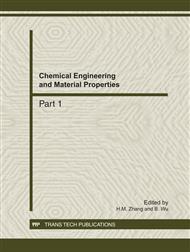p.1132
p.1138
p.1143
p.1149
p.1153
p.1159
p.1164
p.1168
p.1173
The Disassociation of Cordyceps Exopolysaccharide in Aqueous Solution Induced by Ultrasound
Abstract:
The self-aggregation of polysaccharides (PS) in solution has led to high viscosity, unstable biological activity and poor resolution in instrumental characterization as well. In this work, ultrasound with low power level was applied to disrupt the PS aggregation of an exopolysaccharide(EPS) from Cordyceps sinensis mycelial culture. Ultrasonic irradiation with 20% amplitude (about 4 W) for 0.5 min decreased the specific viscosity of EPS by 59%. Dynamic light scattering(DLS) experiments on native EPS showed four distinct population with diameter range of 10~500 nm, 500~2500 nm, 3500~12300 nm and 22150~115400 nm respectively. The peaks at large size range in the intensity-weighted size distribution disappeared or shifted to small size range, indicating a gradual disassociation of EPS with the prolongation of ultrasonic duration. AFM observation proved the disassociation of EPS from a highly across-linked gel into single strand under ultrasonic treatment. According to DLS analysis, ultrasonic treated EPS did not show any sign of aggregation over 8 days in contrast to an immediate aggregation growth with native EPS. Ultrasonic irradiation control PS association by means of weakening the hydrogen bonds through the hydrodynamic shear forces arising from acoustic cavitation in the irradiated liquid, which has importance in the applications and structural characterization of PS.
Info:
Periodical:
Pages:
1153-1158
Citation:
Online since:
December 2011
Authors:
Keywords:
Price:
Сopyright:
© 2012 Trans Tech Publications Ltd. All Rights Reserved
Share:
Citation:


